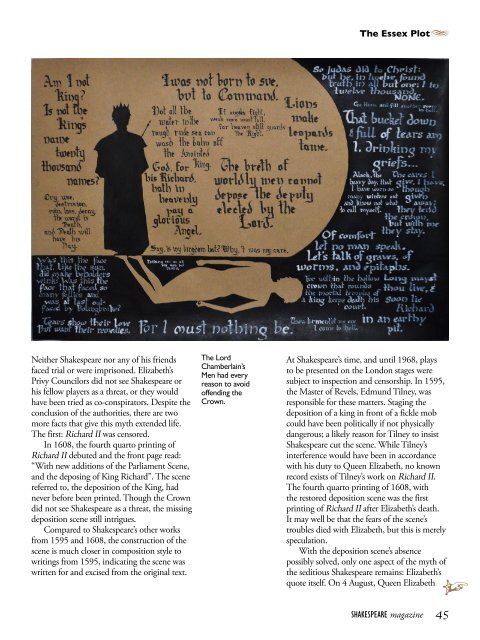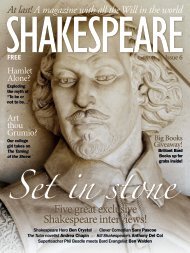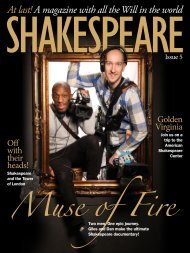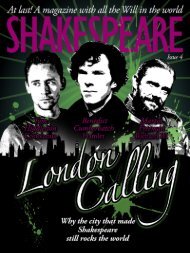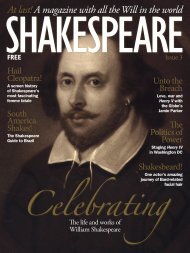Shakespeare Magazine 07
Kenneth Branagh is cover star of Shakespeare Magazine 07, as the issue's theme is Great Shakespeare Actors. Stanley Wells discusses his book on the subject, while Antony Sher reveals what it's like to play Falstaff. We also go behind the scenes of the My Shakespeare TV series, and Zoe Waites chats about playing Rosalind in the USA. Other highlights include Shakespeare in Turkey, Shakespeare Opera, and the real story of Shakespeare and the Essex Plot. All this, and the Russian fans who made their own edition of David Tennant's Richard II!
Kenneth Branagh is cover star of Shakespeare Magazine 07, as the issue's theme is Great Shakespeare Actors. Stanley Wells discusses his book on the subject, while Antony Sher reveals what it's like to play Falstaff. We also go behind the scenes of the My Shakespeare TV series, and Zoe Waites chats about playing Rosalind in the USA. Other highlights include Shakespeare in Turkey, Shakespeare Opera, and the real story of Shakespeare and the Essex Plot. All this, and the Russian fans who made their own edition of David Tennant's Richard II!
Create successful ePaper yourself
Turn your PDF publications into a flip-book with our unique Google optimized e-Paper software.
The Essex Plot <br />
<br />
Neither <strong>Shakespeare</strong> nor any of his friends<br />
faced trial or were imprisoned. Elizabeth’s<br />
Privy Councilors did not see <strong>Shakespeare</strong> or<br />
his fellow players as a threat, or they would<br />
have been tried as co-conspirators. Despite the<br />
conclusion of the authorities, there are two<br />
more facts that give this myth extended life.<br />
The first: Richard II was censored.<br />
In 1608, the fourth quarto printing of<br />
Richard II debuted and the front page read:<br />
“With new additions of the Parliament Scene,<br />
and the deposing of King Richard”. The scene<br />
referred to, the deposition of the King, had<br />
never before been printed. Though the Crown<br />
did not see <strong>Shakespeare</strong> as a threat, the missing<br />
deposition scene still intrigues.<br />
Compared to <strong>Shakespeare</strong>’s other works<br />
from 1595 and 1608, the construction of the<br />
scene is much closer in composition style to<br />
writings from 1595, indicating the scene was<br />
written for and excised from the original text.<br />
The Lord<br />
Chamberlain’s<br />
Men had every<br />
reason to avoid<br />
offending the<br />
Crown.<br />
At <strong>Shakespeare</strong>’s time, and until 1968, plays<br />
to be presented on the London stages were<br />
subject to inspection and censorship. In 1595,<br />
the Master of Revels, Edmund Tilney, was<br />
responsible for these matters. Staging the<br />
deposition of a king in front of a fickle mob<br />
could have been politically if not physically<br />
dangerous; a likely reason for Tilney to insist<br />
<strong>Shakespeare</strong> cut the scene. While Tilney’s<br />
interference would have been in accordance<br />
with his duty to Queen Elizabeth, no known<br />
record exists of Tilney’s work on Richard II.<br />
The fourth quarto printing of 1608, with<br />
the restored deposition scene was the first<br />
printing of Richard II after Elizabeth’s death.<br />
It may well be that the fears of the scene’s<br />
troubles died with Elizabeth, but this is merely<br />
speculation.<br />
With the deposition scene’s absence<br />
possibly solved, only one aspect of the myth of<br />
the seditious <strong>Shakespeare</strong> remains: Elizabeth’s<br />
quote itself. On 4 August, Queen Elizabeth<br />
SHAKESPEARE magazine 45


